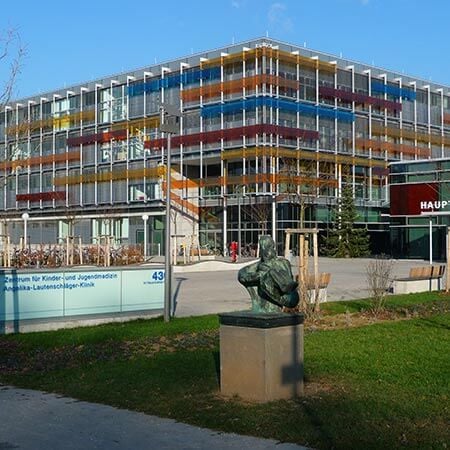If the blood flow is reduced due to narrowing of the aortic valve, there is a need for additional heart work, which can eventually lead to valvular heart disease and other heart conditions.
In terms of treatment, doctors may prescribe surgery for valve reconstruction or replacement. If left untreated, aortic stenosis can lead to serious cardiovascular diseases.
Content
- Overview
- What causes aortic valve stenosis?
- Symptoms of aortic valve stenosis
- Surgery for aortic valve stenosis
- Complications of untreated aortic stenosis
- Best hospitals for treatment
- The cost of treatment in European hospitals
- How to organize the treatment of aortic valve stenosis in Europe?
Overview
By itself, aortic valve stenosis occurs in 2% of all cases of acquired malformations; when combined with valve insufficiency, the disease occurs in almost 23% of cases. If the valve leaflets are inflamed, the tissues thicken, causing the valve opening to narrow over time. Also, the flaps can calcify, severely narrowing the usable area of the valve. In normal conditions, the useful area of the valve orifice is up to 3,5 centimeters in diameter; if the orifice decreases to about 1 square centimeter, hemodynamic abnormalities begin to occur.
At first, when the valve lumen is narrowed, the left ventricle compensates for the abnormality by exerting maximum effort, while a person feels no difference in physical condition. Over time, blood begins to accumulate in the cavity, myocardial tissues stretch, the ventricle begins to contract more actively, the heart muscle "gets tired" and loses endurance. The myocardium of the left ventricle becomes hypertrophied, coronary insufficiency develops, and the heart does not receive the necessary blood supply. Because of that, patients with aortic stenosis have a high risk of sudden death due to severe heart failure.
In addition to complete stenosis of the aortic valve, there is relative stenosis, when the aortic valves are intact, but the ascending part of the aorta is sharply dilated due to arterial hypertension or due to loss of elasticity of the aortic wall. Aortic valve stenosis creates a significant obstruction in the blood flow only if the area of the aortic orifice decreases by more than 50%. Keeping even 10% of its normal value is compatible with life. The lengthening of left ventricular systole (contraction time) and increasing pressure in its cavity, as a compensatory reaction to the aortic orifice, narrowing, cause the development of left ventricular hypertrophy. No other malformation can cause the development of such a significant hypertrophy. Since the left ventricle takes part in the compensation of aortic stenosis, the defect runs for a long time without circulatory disorders. A long compensation period is a peculiarity of this disease.
Aortic valve insufficiency is a frequent companion of aortic valve stenosis. Excessive pressure in the left ventricle provokes an increase in pressure in the left atrium, and then in the vessels of the small circle of blood circulation. The changes primarily affect the connective tissue of the valve.
With persistent and progressive inflammation, the valve flaps become deformed, their edges become thickened, they can twist and sag. As a result, the flaps cannot close hermetically, and blood returns to the heart. If the inflammatory process is stopped, the deformation of the valve may continue, for example, due to the formation of scar tissue.
Until recently, it was thought that the degenerative process in the heart valves was of the same nature as general atherosclerosis. As recent research demonstrates, this does not reflect reality. Recent studies show that aortic valve stenosis is not a passive degenerative disease, but the process of an active permanent and staged nature represented by several scenarios of primary progression, including lipid infiltration into the valve flaps, chronic inflammation, and fibrous tissue replacement with osteoblast activation. Active mineralization of the valve by calcium is a typical feature of pathology development. As a result of such degenerative processes, the valve is destroyed, the flaps are deformed, the area of the valve opening decreases and blood outflow from the left ventricular cavity is obstructed. Ultimately, this leads to the development of myocardial weakness and heart failure.
Despite the apparent similarity of the pathogenesis of aortic valve stenosis with atherosclerosis, the prescription of treatment methods proven effective for one disease, showed no effect in the prevention and treatment of another, which has been confirmed by a large number of scientific studies.
What causes aortic valve stenosis?
In case of congenital aortic valve stenosis, narrowing may be due to the incorrect development of the flaps and their fusion, absence of one of the flaps (when there are two instead of three, but they still completely close the valve opening), and finally due to the narrowness of the area, which these flaps are attached to. People with congenital disease mostly have a combination of these structural changes expressed to a greater or lesser extent.
The following diseases may be the cause of acquired aortic valve stenosis:
- Rheumatism.
- Infective endocarditis.
- Infectious diseases.
- Atherosclerosis.
- Congenital pathology.
Symptoms of aortic valve stenosis
Aortic valve stenosis is more common in men, especially in the elderly, for example, as a result of calcium deposition on the valve leaflets. In young people, congenital anomalies are the most likely to be the cause of stenosis.
Symptoms in patients with aortic stenosis are determined by the cause of the condition, the nature and course of the disease that caused the defect, and the severity and stage of development of the pathology itself.
In the stage of the disease compensation, patients usually have no complaints. The diagnosis is mostly established by accident. Patients with more severe aortic valve stenosis can have dizziness, fainting, increased fatigue, compressive pains in the heart, and the area of upper back at the physical activity (less often at rest). The combination of compressive pain in the heart area with dizziness and fainting is particularly typical for aortic valve stenosis. The occurrence of attacks of cardiac asthma and dyspnea at rest indicates a significant progression of stenosis. The pallor of the skin is observed.
Clinical manifestations of aortic valve stenosis depend on the severity of the impact of the disease on the body. Thus, some newborns with critical stenosis, whose heart was working alongside great resistance even before their birth, have pronounced symptoms. Such children have frequent breathing and high heart rate, lethargy, and poor appetite. In the most severe cases, these patients may need artificial respiration and treatment in the intensive care unit. They should immediately undergo endovascular or surgical treatment. Non-significant stenoses may not manifest themselves. In such cases, routine monitoring by a cardiologist and periodic cardiac examinations are mostly recommended to help monitor the progression of the stenosis.
Surgery for aortic valve stenosis
Surgery is usually at the core of treatment tactics for aortic valve stenosis. There are different types of surgery that can be used for the treatment of the diagnosis. The main ones include a balloon or surgical valvuloplasty, and conventional or transcatheter aortic valve replacement.
When performing balloon aortic valvuloplasty, the doctor is handling a catheter with an inflatable balloon connected to it. The doctor directs it and when it reaches the targeted location, the balloon inflates and widens the valve, consequently improving blood flow in it. Balloon valvuloplasty manages aortic valve stenosis and its symptoms, especially when we are talking about congenital stenosis, usually in children. However, in adults, even after successful surgery, the results usually do not last. For this reason, doctors rarely use this method of treatment for adult patients, except for those with a general health condition unsuitable for a full-spectrum operation.
In rare cases, surgical valvuloplasty may be more effective than balloon valvuloplasty: for example, for newborns with congenital aortic valve malformation when the valves are fused. With conventional surgical instruments, the cardiac surgeon separates the flaps to reduce the narrowing and improve blood flow.
However, aortic valve replacement is the primary type of the surgical treatment for the severely narrowed aortic valve. During the intervention, the surgeon replaces the affected valve with an artificial valve. This happens during open-heart surgery.
Mechanical valves are durable but carry the risk of blood clotting. If a patient gets such an artificial valve, they will have to take anticoagulant drugs for life. The biological one has to be replaced over time. Another reserved option is the patient's own valve from the pulmonary artery.
Transcatheter aortic valve implantation is a less invasive way for aortic valve replacement.
Transcatheter aortic valve implantation is usually performed for patients with severe pathology who have an increased risk of complications after surgery. However, this type of intervention has greater risks of stroke and vascular complications than conventional aortic valve replacement surgery. This method is relatively new and is developing very rapidly.
Aortic valve stenosis can be effectively treated by surgery. However, patients need to have regular checkups and see a doctor to monitor the health condition. Patients may have a risk of arrhythmia even after treated aortic valve stenosis, which can be regulated with additional medications that reduce the risk. If the heart is weakened by aortic valve stenosis, patients may need medications to treat heart failure.
If patients had surgery for aortic valve replacement, doctors recommend taking prophylactic antibiotics before certain medical interventions to prevent the inflammation of endocarditis.
Complications of untreated aortic stenosis
The heart has four valves at its disposal to keep it working smoothly: mitral and tricuspid, aortic and pulmonary that receive the blood expelled from the heart.
When a heart valve pathology leads to abnormalities in the heart functioning, we can talk about a heart defect. Congenital and acquired defects are distinguished by their origin. According to the mechanism of the resulting disorders, all heart defects are divided into two large groups: stenosis and insufficiency.
Regardless of the origin and specific kind of hemodynamic disorders, the result of the existence of the defect is, eventually, the same – an increased load on the heart, which ultimately leads to the development of circulatory failure and the occurrence of irreversible changes, both in the heart functioning and functioning of other vital organs and tissues (lungs, kidneys, liver, etc.). Therefore, it is necessary to correct the heart defect in time, when it is possible to heal fully and return the patient to an active life without any restrictions.
So, are there any potential consequences of untreated stenosis? Since it pushes the left ventricle to work extra to facilitate the blood getting through the constriction area, it gradually gets worn out working in this mode, which results in different defects in its structure and general disruptions in functioning like stretching of its wall, enlargement of its cavity, and development of heart failure.
If left untreated, aortic valve stenosis causes life-threatening problems to appear, including:
- Angina pectoris.
- Frequent fainting.
- Heart failure.
- Cardiac arrest.
Best hospitals for treatment
According to statistics, up to 98% of patients who underwent treatment in European hospitals tolerate cardiac surgery well, without any complications. Open heart valve replacement interventions in Europe are performed using sparing surgical techniques, and cardiac surgeons always try to limit the extent of interventions to a minimum. Generally, medical manipulations on the heart are serious operations that impose a bunch of restrictions on the lifestyle of patients. However, the vast majority of people who have undergone cardiac surgery in European hospitals report minimal consequences and a significant improvement in their general health condition. Patients are assured of the satisfactory treatment outcomes in Europe due to high-tech equipment, the vast experience of European doctors, as well as efficiently designed facilities and departments that create conditions for cooperation between doctors of different specializations.
The following hospitals are considered the best in Europe for undergoing aortic valve stenosis treatment:
- University Hospital Oldenburg, Germany.
- University Hospital Essen, Germany.
- University Hospital Ulm, Germany.
- University Hospital Frankfurt am Main, Germany.
- University Hospital Tuebingen, Germany.
- University Hospital Erlangen, Germany.
You can find more detailed information about hospitals and the conditions of stay for inpatient treatment in the Departments of Cardiac Surgery on the Booking Health website.
The cost of treatment in European hospitals
The average prices for aortic stenosis treatment are:
- The cost of treatment with balloon valvuloplasty starts at 5,165 EUR.
- The cost of treatment with valve replacement starts at 9,746 EUR.
- The cost of treatment with transcatheter valve replacement starts at 17,015 EUR.
- The price of diagnostics starts at 468 EUR.
- The price of cardiac rehabilitation starts at 566 EUR.
More information about the cost of treatment of aortic valve stenosis in Europe is available on the Booking Health website.
How to organize the treatment of aortic valve stenosis in Europe?
The experience of cardiac surgeons, as well as the use of new treatments for various heart diseases justify an excellent reputation that extends far beyond Europe. To give patients the best possible treatment, doctors have access to modern surgical techniques. But how to actually start the treatment in Europe?
The treatment in European hospitals is easy with services provided by Booking Health.
Whether you need emergency medical care or plan to undergo surgical treatment, you can count on Booking Health in selecting the most suitable hospital and specialist for you. Besides, Booking Health will provide you with a cost of treatment guarantee.
For more information, please leave your request and we will contact you as soon as possible.
Authors: Dr. Nadezhda Ivanisova, Dr. Sergey Pashchenko




















